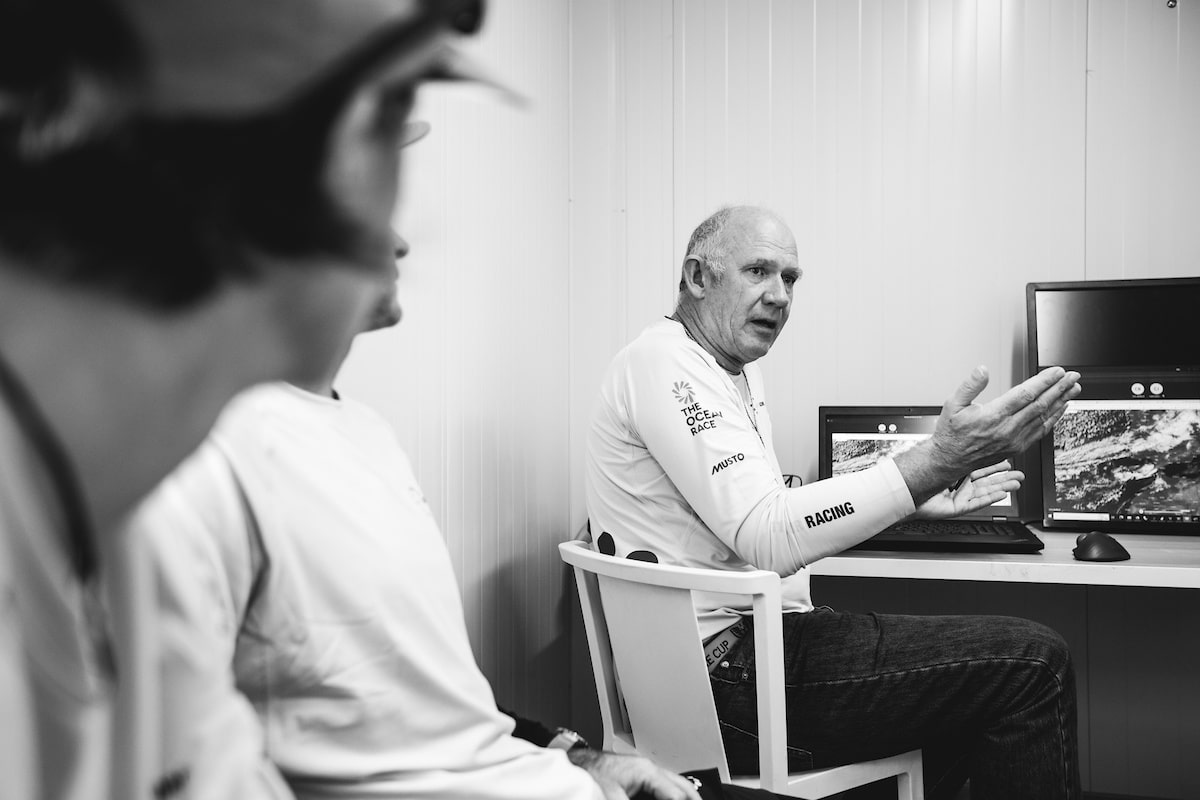SNAKES AND LADDERS WITH MARCEL THE STRATEGIST
Marcel Van Triest is the strategic meteorologist for 11th Hour Racing Team. The Ocean Race 2022-23 is the ninth race for the Dutchman, having competed as navigator in the 1989/90 and 1993/94 Whitbreads, as well as the Volvo Ocean Race 1997/98, 2001/02, and 2005/06. On the eve of the race start, and moments after the sailing team’s penultimate weather briefing, we caught up with him to hear what’s in store for the crew of Mālama in the first leg of the race, destination Cabo Verde.
What were the main takeaways?
Main takeaways really are there are two big potholes already before they get to the corner, to Cabo de Gata, and into the Alboran Sea where there are chances to lose quite a bit, and not that many chances to gain quite a bit.
So probably they will stay fairly conservative early on tactically, then once they get in to the Albora Sea, which is around the corner, it is going to be quite windy, 25-30, low 30s, with a pretty short sea state, so that’s going to be tough as well in a completely different way. So it will be about boat preservation, I think.
Then the main takeaway after that is that once they get out, it will be pretty quick to get to Cabo Verde. All the hardship, both tactically and for the boat, will be in the Mediterranean. Once they are out, it will be one more little tack and then way offshore, one gybe, Cabo Verde, finish. So whoever comes out of Gibraltar first, it will be their leg to lose, I think. That will be tough – two tactical potholes and a difficult stretch for the boats.
Is this weather in the Mediterranean typical?
It is very typical. The way that Gibraltar is, and the Alboran Sea, it is kind of Easterly or Westerly, there are only really two directions. So unfortunately it is westerly, but that is not unheard of with all the lows this winter. The Alboran Sea is a nasty place most of the time.
During racing, what’s your role with the team?
Well, first of all, the leg is so short and it’s a really short stopover in Cape Verde, so as soon as they are gone, I will be looking forward to the next leg, keep that routine. So we’ll keep going with our daily briefings and we’ll be talking about the Doldrums and what to do with South American cold fronts while they are still on their way to the Cape Verde’s because it will all happen really quickly.
We need to be prepared once they hit the shore in the Cape Verde’s, Si Fi will straightaway get up to speed, going through the Sailing Instructions, the geometry of the leg, the waypoints, and all that sort of stuff.
And of course keep an eye on how they performed and see if I think they missed something, if there’s something to be learned, if they did something really well or if there was a small mistake somewhere. So I’m trying to improve the results, basically.
Which weather models do you use and how many of them are there?
You don’t want to know! There are so many of them. When people talk about a weather model, when they look at the Windy app for example, that’s just one model, right?
So if we talk about the most famous one, the American GFS model, that’s what we call the deterministic model, and that’s like the best guess. But then you’ve got this theory of a butterfly that flaps its wings on the equator, which leads to a hurricane, two weeks from now in the Atlantic.
So what they do then is they take that model because that’s the best guess, they have a look at the atmosphere through observations and planes and balloons and ships and pictures and all that sort of stuff. This is the current state of the atmosphere. Then they put physics on it and make a forecast. Once they’ve done that, they go back to the current state of the atmosphere, and they make small mistakes in it – perturbation we call it – and then they rerun it again. And they do that like 30 times or 50 times. So in GFS for instance, there’s something called the ensemble models, which is 30 slightly twisted versions of GFS. And it’s to see how stable the prediction is basically, if we introduce a small mistake in the initial condition, does that change the forecast in five days from now or does it stay the same anyway? That’s about the butterfly, basically!
How many races have you worked on?
This is my ninth race, and I’ve done this my whole life. I’m not a meteorologist, first of all. I don’t have that hat, I don’t have that qualification, I don’t pretend to be one. Maybe I’m more of an applied meteorologist. Because if you speak to a meteorologist, they will give you 50 different definitions of rain, and how a front comes through, it can shift this way, or that way. As a strategist, you don’t really care about the front coming as there are only two solutions – you either go towards it, or you stay on the course that takes you closest to the mark, and it will come to you. Those are the only two solutions. How the front is exactly, is irrelevant. So I try to apply meteorology to the strategy.




